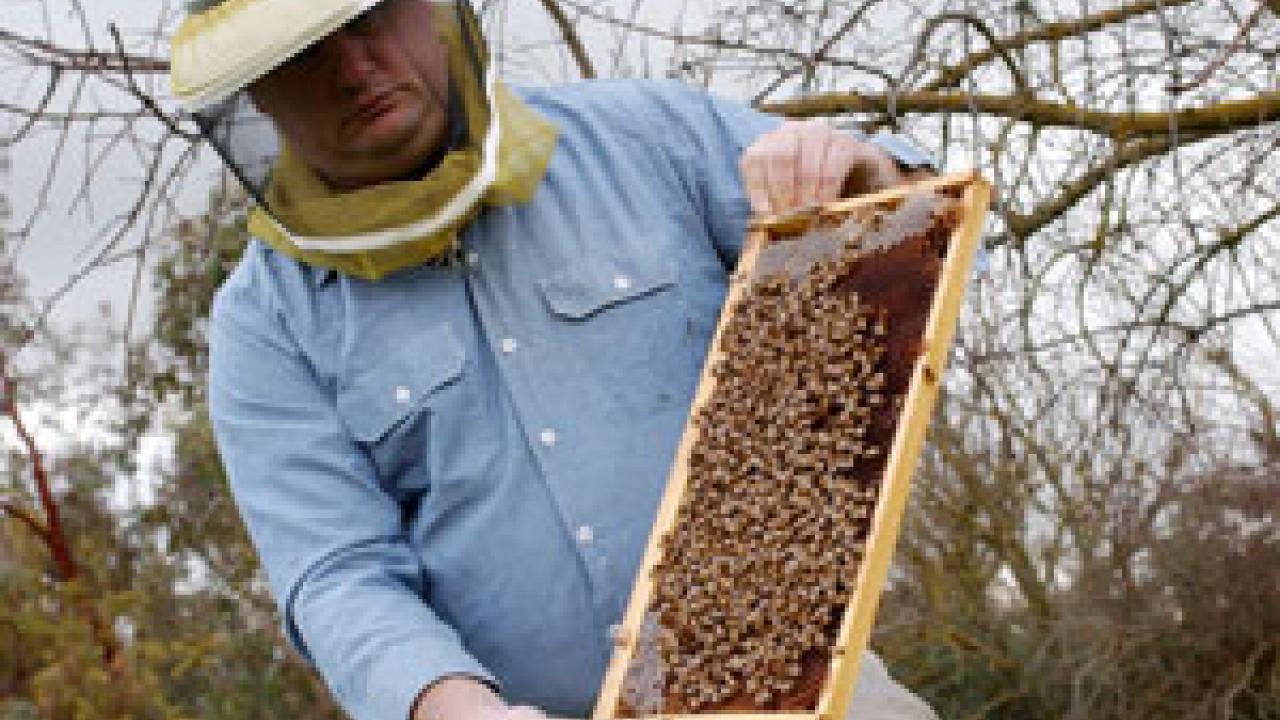Commercial beekeepers are worried that a tiny parasitic mite that destroys the lifecycle of honeybees might devastate their industry and cost the nation's fruit and nut farmers billions of dollars.
The Varroa mite, officially known as the Varroa jacobsoni, is a crab-shaped arachnid the size of a pinhead that attaches itself to a bee and sucks its blood for sustenance. Eric Mussen, a UC Davis Extension bee expert who provides scientific guidance to California's bee keepers, says the Varroa mite is now resistant to all registered pesticides. And that means big trouble for farmers and their agricultural commodities that depend on honeybees for pollination.
"If for some reasons we were to lose all of our honeybees, California would be out about $4.4 billion worth of crops," Mussen said. Our daily diets would change dramatically, he added, "because about one third of the food we consume every day is the product of honeybee pollination."
The mite's impact has already hit Dixon beekeeper Phil Hofland hard. Hofland, who maintains more than 2,000 hives throughout Northern California, says that when he started in the business 25 years ago, typically about 5 to 10 percent of his hives would die each year. But he began this year with a loss of 30 to 35 percent. "There are going to be a lot of beekeepers this year that are not going to come back," he said.
From a grower's perspective, almond ranchers have the most to fear -- and lose. California grows 100 percent of the nation's almond crop and 80 percent of all almonds harvested worldwide. Experts say almonds are the state's biggest agricultural export, valued at $1.6 billion, and the ranchers who grow them are dependent on the dozens of healthy beeshives used to pollinate their orchards each year. This year, for example, nearly one million beehives will be placed across a half million acres of nut trees.
Mussen explained that whenever pesticides are used to target and control a particular pest, "some escape because you miss them, but some escape because they have biochemistry that allows them to make it through that chemical treatment." As a consequence, then, this population of pests grows increasingly resistant to the treatment as the treatment continues over time. That is the case with the Varroa mite.
The mites were discovered in Asia in 1904, but they did not appear in the United State until 1984. Beekeepers find them challenging because they overwhelm the colonies by sucking the blood of adult bees and also by spreading diseases that eventually kill the bees.
Mussen said that American growers actually are fortunate that the Varroa mite is the only destructive mite from Asia that has made its way across the Pacific Ocean. "There are other mites, one of which we think is even worse than this one, that we haven't got yet," he said. As a result, Mussen points out that the agricultural quarantines play an important role in keeping out these other dangerous mites.
The immediate future for bees is bleak. However, scientists are continuing to look for both biological and chemical control agents that will work against the Varroa mite. The challenge for researchers is how to kill one invertebrate -- the mite -- without harming another -- the bee.
Mussen said one approach is to incorporate into bee colonies genetic material from honeybees that have survived mite infestations. Researchers are studying what they are referring to as a "SMART" bee, which comes from SMR for suppression of mite reproduction. These bees turn out to be highly hygienic bees that keep their colonics clean of tainted and contaminated materials, including mite-infested broods.
When the SMART bees sense by smell that the brood is infested, they will dig it out and remove it from the colony. Mussen says there is an ongoing effort to incorporate that genetic material into commercial bees across the country.
Mussen said another promising remedy is being developed by a U.S. Department of Agriculture laboratory in Arizona. It is a compound called 2-heptanone, a naturally occurring bee pheromone produced in the head of the bee that is toxic to mites.
The USDA is microencapsulating the material in starch and then blending sugar and the starch material together to make sort of a candy bar, he said. The bar is then placed in the hives, and as the bees chew on the sugar, they release the 2-heptanone.
"We don't know if that is going to be effective," Mussen said, "but let's hope so."
Media Resources
Mitchel Benson, (530) 752-9844, mdbenson@ucdavis.edu
